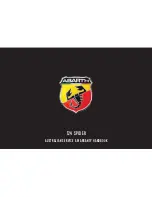
ingested by a child or pet, seek emergency
assistance immediately. Clean up any ground
spills immediately.
Coolant Level
The coolant bottle provides a quick visual
method for determining that the coolant level is
adequate. With the engine idling and warm to
normal operating temperature, the level of the
engine coolant (antifreeze) in the bottle should
be between the “ADD” and “FULL” lines shown
on the bottle.
The radiator normally remains completely full,
so there is no need to remove the radiator cap
unless checking for the coolant freeze point or
replacing the engine coolant (antifreeze). Ad-
vise your service attendant of this. As long as
the engine operating temperature is satisfac-
tory, the coolant bottle need only be checked
once a month.
When additional engine coolant (antifreeze) is
needed to maintain the proper level, it should be
added to the coolant bottle. Do not overfill.
Points To Remember
NOTE:
When the vehicle is stopped after a few
miles/kilometers of operation, you may ob-
serve vapor coming from the front of the
engine compartment. This is normally a re-
sult of moisture from rain, snow, or high
humidity accumulating on the radiator and
being vaporized when the thermostat opens,
allowing hot engine coolant (antifreeze) to
enter the radiator.
If an examination of your engine compartment
shows no evidence of radiator or hose leaks,
the vehicle may be safely driven. The vapor will
soon dissipate.
•
Do not overfill the coolant expansion bottle.
•
Check the coolant freeze point in the radiator
and in the coolant expansion bottle. If engine
coolant (antifreeze) needs to be added, the
contents of the coolant expansion bottle must
also be protected against freezing.
•
If frequent engine coolant (antifreeze) addi-
tions are required, the cooling system should
be pressure tested for leaks.
•
Maintain engine coolant (antifreeze) concen-
tration at a minimum of 50% OAT coolant
(conforming to MS-12106) and distilled water
for proper corrosion protection of your engine
which contains aluminum components.
•
Make sure that the coolant expansion bottle
overflow hoses are not kinked or obstructed.
•
Keep the front of the radiator clean. If your
vehicle is equipped with air conditioning,
keep the front of the condenser clean.
•
Do not change the thermostat for Summer or
Winter operation. If replacement is ever neces-
sary, install ONLY the correct type thermostat.
Other designs may result in unsatisfactory en-
gine coolant (antifreeze) performance, poor gas
mileage, and increased emissions.
233
Содержание Compass
Страница 1: ...Compass O P E R A T I N G I N F O R M A T I O N...
Страница 2: ......
Страница 3: ......
Страница 4: ......
Страница 6: ...2...
Страница 11: ...7...
Страница 64: ...60...
Страница 84: ...80...
Страница 85: ...81...
Страница 86: ...82...
Страница 118: ...114...
Страница 122: ...INSTRUMENT CLUSTER GAS 118...
Страница 123: ...INSTRUMENT CLUSTER DIESEL 119...
Страница 138: ...Compass Variance Map 134...
Страница 149: ...145...
Страница 153: ...Control Setting Suggestions for Various Weather Conditions 149...
Страница 154: ...150...
Страница 204: ...200...
Страница 277: ...SPAIN 290 SWEDEN 290 SWITZERLAND 290 TAIWAN 291 TURKEY 291 UKRAINE 291 UNITED KINGDOM 292 URUGUAY 292 VENEZUELA 292 273...
Страница 297: ...293...
Страница 298: ...294...
Страница 299: ...10 INDEX 295...
Страница 308: ......
Страница 309: ......
Страница 310: ...Chrysler Group LLC 14MK49 126 EE AA Printed in Europe 14...
















































